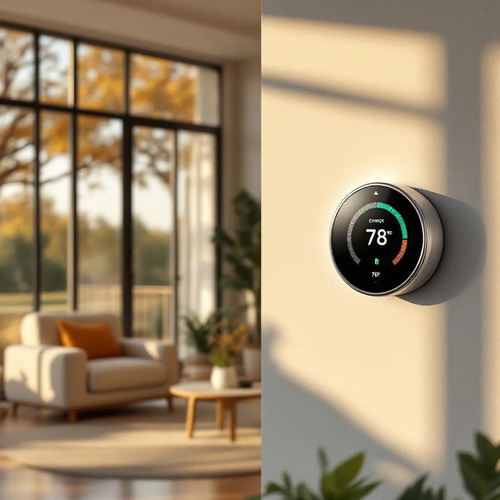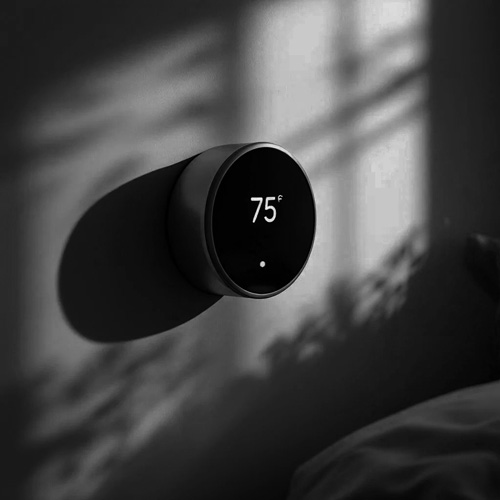When the Texas summer hits triple digits, staying cool without skyrocketing your energy bill becomes a top priority. Whether you’re at home in Plano or running a small business in Dallas, setting your thermostat smartly makes a big difference. In this article, we’ll walk you through the recommended thermostat settings for summer:
- at home,
- away,
- and at night
Recommendations are based on 2025 guidance from ENERGY STAR, major Texas utilities like Oncor, Reliant, and TXU Energy, and other energy companies.
Finding Your Summer Comfort Zone in Texas
Finding your summer comfort zone in Texas isn’t always easy, especially when the mercury climbs and your energy bills threaten to do the same. With the intense heat of the summer months, it’s important to strike a balance between a comfortable indoor temperature and energy efficiency. According to the Department of Energy, setting your thermostat to 78 degrees Fahrenheit is a smart way to save on cooling costs, potentially reducing your energy bills by up to 3%.
However, the best temperature for your home depends on several factors, including your personal preference, the difference between indoor and outdoor temperatures, and the type of heating and cooling system you use. By adjusting your thermostat settings thoughtfully, you can keep your cooling system working efficiently, stay cool, and avoid higher energy bills.
In this guide, we’ll help you discover the ideal temperature settings for your home so you can enjoy both comfort and savings all summer long.
Best Thermostat Setting When You’re Home

- Recommended: 78°F (25.5°C) – This is the ideal thermostat temperature recommended by experts for summer.
- Why: Balances comfort with energy savings and helps maintain a comfortable temperature for most people, though personal comfort may vary.
- Pro Tip: Use a ceiling fan and humidity control to feel cooler without lowering the target temperature on the thermostat.
Many Texans prefer slightly cooler settings (like 74–75°F), especially during the hottest afternoons.
If 78°F feels too warm, lower it one degree at a time to find your sweet spot. It may take a little trial and error to discover your preferred setting.
78°F is considered the standard setting for many households during summer. Adjusting the thermostat impacts your home’s temperature and overall comfort, and raising the temperature by a few degrees can improve energy efficiency.
How to Save
Ceiling Fan
Using a ceiling fan allows you to set your air conditioner temperature a bit higher while still feeling cool, as fans help circulate cool air throughout the room. Approximately, it makes you feel 4°F cooler without lowering the thermostat.
Set your ceiling fan to spin counterclockwise in summer for optimal airflow and cooling efficiency.
Humidity control
Humidity control is also essential for maintaining comfort during hot Texas summers and can allow you to set a higher temperature without losing comfort.
Thermostat Settings When You’re Away

Setting the thermostat higher when away can reduce costs and maximize savings.
- Recommended: 82–85°F (the recommended settings for when the house is unoccupied)
- Why: There’s no need to cool an empty house or building. Setting the thermostat to a higher setting when away helps save money and reduce your electric bill.
- Guidance: Reliant’s “4-by-4” rule: raise the temp 4°F above your normal setting if you’re gone for 4+ hours.
- Adjusting the thermostat impacts your home’s temperature and overall comfort when you return, so use a smart thermostat to schedule cooling in advance. The ideal temperature serves as a baseline for these adjustments.
Smart thermostats make this easy.
Set a schedule so your home cools back down before you return.
If you have pets, aim for 76–80°F to keep them safe and comfortable!
Ideal Setting for Sleep

- Recommended: 72–75°F for most Texans
- Why: Cooler rooms improve sleep quality; setting the thermostat to a cooler temperature at night can help you rest better.
- Energy Tip: Schedule a 1–2°F increase closer to morning hours to save more.
The most comfortable temperature for sleep varies from person to person, so it may take a little trial and error to find your ideal setting.
When deciding what temperature to set the thermostat at night, experts recommend a temperature between 72–75°F for optimal sleep comfort.
Humidity control is also crucial for sleep comfort during hot summer nights, as excess humidity can disrupt rest.
If you run hot at night, go ahead and lower the temp slightly. Avoid dropping below 70°F unless necessary. Fans can help maintain comfort at higher temperatures.
Business Hours & After-Hours (Light Commercial)

- Occupied: 74–76°F (this is the normal setting for business hours and serves as a baseline for adjustments. It is also considered the ideal thermostat temperature for comfort and efficiency)
- Unoccupied: 80–85°F or turn the system off (using a higher setting when the building is unoccupied helps save money on your electric bill and reduces wear on your HVAC system and AC)
- Why: Matches OSHA comfort range (68–78°F) while managing energy costs. Recommended settings for businesses are based on expert advice and energy companies’ guidelines.
For retail and office spaces, set the thermostat higher after hours to reduce energy use and extend the life of your HVAC and air conditioning system. Program setbacks after hours – this simple step can save up to 30% on cooling costs and help save money on your electric bill without sacrificing employee or customer comfort. To optimize business comfort and savings, consider setting the temperature for occupied hours and following the recommended thermostat settings for your air conditioning system.
Thermostat Placement & Installation.
Getting It Right
By getting your thermostat placement and installation right, you’ll keep your home cool, reduce unnecessary expense, and make your summer energy bills more manageable.
Where you install your thermostat can make a big difference in how well your heating and cooling system performs – and how much you save on your energy bill. For the most accurate temperature readings and efficient operation, always place your thermostat on an interior wall, away from direct sunlight, air leaks, and heat sources like lamps or appliances. This helps your thermostat sense the actual indoor temperature, so your cooling system doesn’t work harder than necessary.
Programmable thermostat
Upgrading to a programmable thermostat allows you to set different temperature settings for various times of the day, automatically adjusting to your schedule and helping you save energy. For even greater efficiency, consider a smart thermostat, which can learn your habits and optimize your home’s temperature for both comfort and savings.
Bonus Tips for Summer Savings
- Smart thermostats: Automate comfort based on your routine.
- Block heat: Close blinds/curtains during peak sun.
- Use Auto fan mode: Helps circulate cool air more efficiently and prevents blowing warm, humid air when the AC is off.
- Maintain your system: Clean filters monthly to keep cool air flowing efficiently, and schedule regular AC and HVAC system tune-ups for optimal performance.
- Check humidity control: Adjust humidity control settings to improve comfort and energy efficiency.
These tips can help you save money and lower your electric bill.
Remember: Regular maintenance of air conditioning and HVAC systems also leads to significant savings potential over time.

Stay Cool and Save Big This Summer
At AirMatics, we help homeowners and businesses across Plano, Frisco, McKinney, Dallas, and beyond stay comfortable and keep bills low with expert AC and HVAC system services.
Whether it’s upgrading your thermostat, tuning up your air conditioner, maintaining your HVAC system, or evaluating your energy usage, we’ve got you covered.
Using AirMatics’ services can help you save money and achieve greater energy savings on your utility bills. Regular maintenance of AC and HVAC systems is key to long-term savings and optimal performance.
FAQs: Summer Thermostat Settings in Texas
Yes, especially with fans. Many Texans start here and adjust slightly for personal comfort. This is considered the ideal thermostat temperature and a recommended thermostat setting for most homes. Still, it may take a little trial and error to find what works best for your comfort and savings.
No. Your AC cools at the same rate regardless of the setting. Setting the thermostat to a cooler temperature does not speed up cooling and may increase your electric bill by overworking the system.
Aim for 82–85°F to prevent heat damage without wasting energy. Raising the thermostat a few degrees higher than your standard setting helps save money, and a little trial and error can help you find the best balance for your home.
Not during a Texas summer. Instead, schedule a slight temp increase after falling asleep to save energy. Using a higher setting for the thermostat at night can help with saving energy and reducing costs.
A common question is, “What temperature should I set the thermostat to in summer?” The Department of Energy recommends setting your air conditioner temperature to 78°F when you are home for optimal comfort and energy efficiency. This recommended thermostat setting is a good starting point, but a little trial and error may be needed to find your ideal balance.
Air conditioning systems regulate your home’s temperature by removing heat and circulating cool air throughout your living spaces. Keeping doors and windows closed and ensuring good insulation helps prevent cool air from escaping, making your system more efficient.
Humidity control is essential for comfort during hot summer months. Proper humidity control helps your air conditioning system maintain a comfortable indoor environment and can also improve energy efficiency and indoor air quality.
Outdoor temperature plays a big role in how well your cooling system works. On extremely hot days, your AC may need to work harder to maintain your desired indoor temperature. Adjusting the settings of the thermostat according to the outdoor temperature can enhance comfort and improve energy efficiency.
In winter, set your heating system to a recommended temperature, such as 68°F when home and awake, to keep your house warmer efficiently. Lowering the thermostat when you are away or asleep can help reduce heating bills. Finding the right setting may take a little trial and error, but it can lead to significant savings on your energy costs.